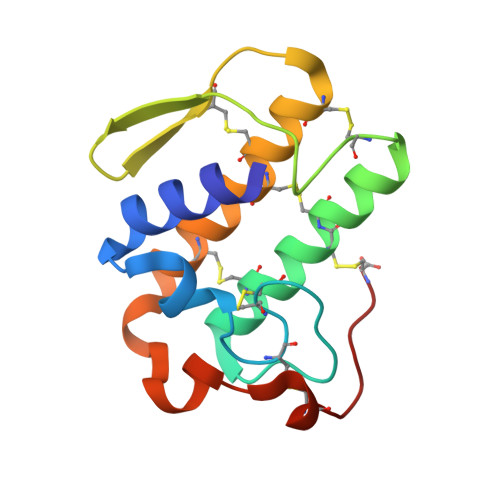Selective Inhibition of Human Group IIA-secreted Phospholipase A2 (hGIIA) Signaling Reveals Arachidonic Acid Metabolism Is Associated with Colocalization of hGIIA to Vimentin in Rheumatoid Synoviocytes.
Lee, L.K., Bryant, K.J., Bouveret, R., Lei, P.W., Duff, A.P., Harrop, S.J., Huang, E.P., Harvey, R.P., Gelb, M.H., Gray, P.P., Curmi, P.M., Cunningham, A.M., Church, W.B., Scott, K.F.(2013) J Biological Chem 288: 15269-15279
- PubMed: 23482564
- DOI: https://doi.org/10.1074/jbc.M112.397893
- Primary Citation of Related Structures:
3U8B, 3U8D, 3U8H, 3U8I - PubMed Abstract:
Human group IIA secreted phospholipase A2 (hGIIA) promotes tumor growth and inflammation and can act independently of its well described catalytic lipase activity via an alternative poorly understood signaling pathway. With six chemically diverse inhibitors we show that it is possible to selectively inhibit hGIIA signaling over catalysis, and x-ray crystal structures illustrate that signaling involves a pharmacologically distinct surface to the catalytic site. We demonstrate in rheumatoid fibroblast-like synoviocytes that non-catalytic signaling is associated with rapid internalization of the enzyme and colocalization with vimentin. Trafficking of exogenous hGIIA was monitored with immunofluorescence studies, which revealed that vimentin localization is disrupted by inhibitors of signaling that belong to a rare class of small molecule inhibitors that modulate protein-protein interactions. This study provides structural and pharmacological evidence for an association between vimentin, hGIIA, and arachidonic acid metabolism in synovial inflammation, avenues for selective interrogation of hGIIA signaling, and new strategies for therapeutic hGIIA inhibitor design.
- Faculty of Pharmacy, The University of Sydney, Sydney, New South Wales 2006, Australia.
Organizational Affiliation:


















